#NASA Eclipse Explorer
Explore tagged Tumblr posts
Text
2024 Total Solar Eclipse: Where & When to See It in North America
The 2024 total solar eclipse is coming! Learn when and where it's visible, understand the science behind eclipses, and get essential safety information
Get ready for a celestial spectacle! Today, April 8th, 2024, a total solar eclipse will grace the skies of North America, casting a shadow of darkness across the continent. This rare and awe-inspiring event is an opportunity to witness the power and beauty of the cosmos firsthand. So, where and when can you catch this breathtaking phenomenon? Get Ready for a Once-in-a-Lifetime Experience Prepare…
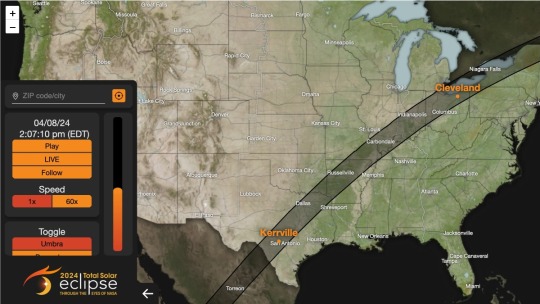
View On WordPress
#2024 eclipse#astronomy#Celestial events#eclipse#Eclipse safety#NASA Eclipse Explorer#Path of totality#solar-eclipse#space#sun#Total solar eclipse
0 notes
Text
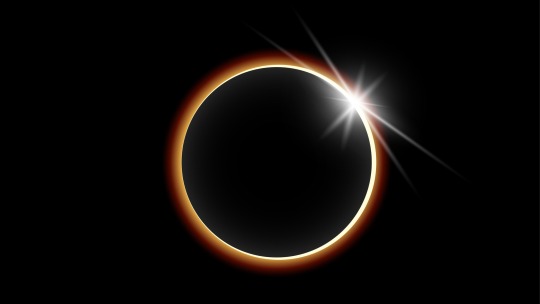
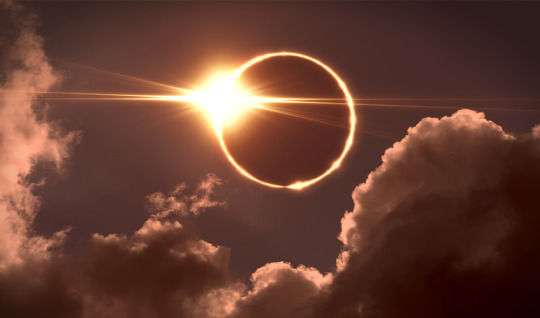
(NEW UPDATE WITH PHOTOS) Send us your best photos!
Absolutely beautiful! I hope everyone took this in! Makes you think just how small we are. A moment the world comes together as one! That’s true humanity . We will be uploading more amazing photos to this same post. So come back later on and check out our 2024 once in a lifetime eclipse photos.
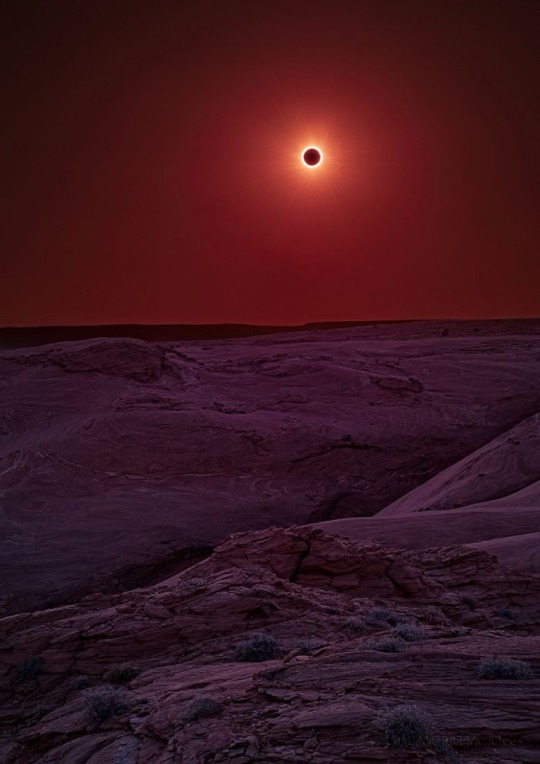
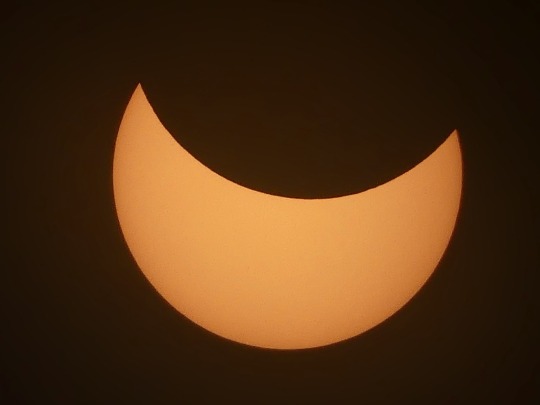

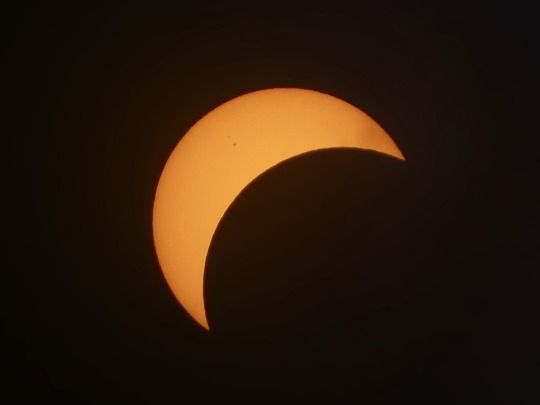

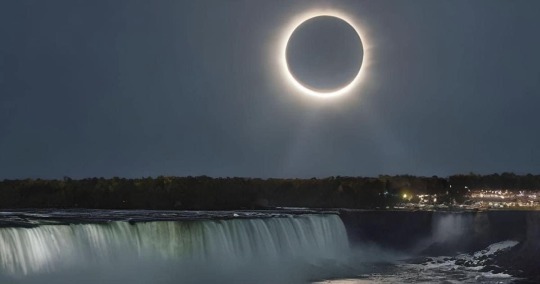
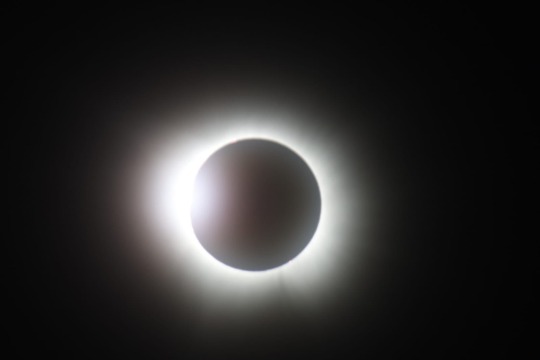
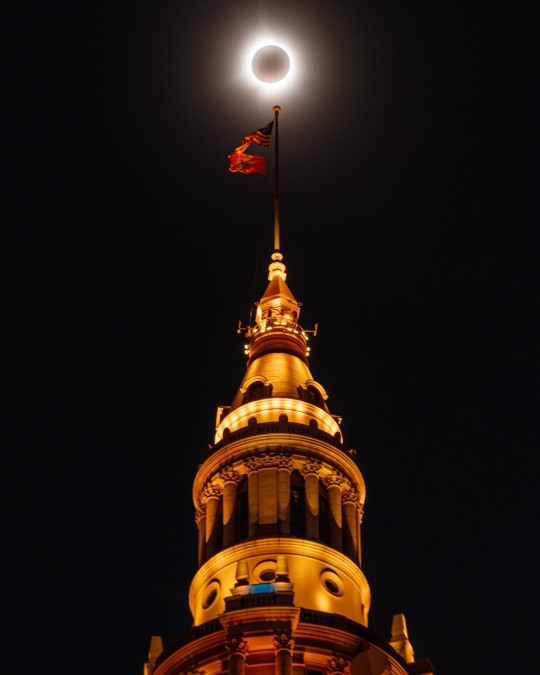
#solar eclipse#eclipse 2024#2024#astronomy#astronomers#nasa#universe#astrophotography#nasa photos#astrophysics#outer space#nasawebb#hubble space telescope#i love astronomy#astronomy facts#astrography#astrobiology#astronauts#astro community#space program#planetary science#planetary nebula#international space station#space exploration#space#science facts#space science#sci#astro notes#astro observations
6K notes
·
View notes
Text

Eclipse eclipse eclipse!
#travel photography#photography#space aesthetic#astrophotography#outer space#space photography#full moon#eclipse solar#eclipse totality#total eclipse#eclipse#nasa photos#nasa#space exploration
9 notes
·
View notes
Link
Astronomy Daily | Space News: S04E58 In this episode of Astronomy Daily, host Anna takes you on an exhilarating journey through the latest advancements and discoveries in the cosmos. From classified space missions to lunar eclipses, this episode is packed with stories that highlight the ever-evolving landscape of space exploration. Highlights: - X37B Spaceplane's Latest Mission: Discover the impressive achievements of the US Space Force's X37B spaceplane, which recently completed a 434-day mission. We discuss its innovative aerobraking maneuver and the significance of its experiments in space domain awareness. - International Space Station Crew Rotation: Get the latest updates on Expedition 72 as NASA astronauts prepare for a crew transition aboard the ISS. Learn about the ongoing research into human adaptation to microgravity and the exciting activities taking place in this unique orbital laboratory. - Intuitive Machines' Lunar Mission Conclusion: We cover the dramatic end of Intuitive Machines' Nova Sea lander mission, which, despite landing on its side, managed to return valuable data. Explore the implications of this mission for future lunar exploration efforts. - NASA's Search for Artemis Mascot: Join us as we explore NASA's call for designers to create a zero gravity indicator for the Artemis 2 mission. This initiative connects creativity with space exploration, offering a unique opportunity for the global community. Details here: https://www.freelancer.com/contest/Moon-Mascot-NASA-Artemis-II-ZGI-Design-Challenge-2527909/details - Upcoming Total Lunar Eclipse: Mark your calendars for March 14 as we prepare for the first total lunar eclipse of 2025. We'll provide essential viewing information and discuss the significance of this celestial event. - Discovery of a Supermassive Black Hole: In a groundbreaking revelation, scientists have found evidence of a supermassive black hole in the Large Magellanic Cloud. Learn about the implications of this discovery and how it reshapes our understanding of our galactic neighborhood. For more cosmic updates, visit our website at astronomydaily.io. Join our community on social media by searching for #AstroDailyPod on Facebook, X, YouTubeMusic, and TikTok. Don't forget to subscribe to the podcast on Apple Podcasts, Spotify, iHeartRadio, or wherever you get your podcasts. Thank you for tuning in. This is Anna signing off. Until next time, keep looking up and stay curious about the wonders of our universe. 00:00 - Welcome back to Astronomy Daily 01:05 - X37B spaceplane mission update 07:30 - ISS crew rotation news 12:15 - Intuitive Machines' lunar mission update 18:00 - NASA's Artemis mascot design contest 22:30 - Upcoming total lunar eclipse details 27:00 - Discovery of a supermassive black hole 32:00 - Conclusion and upcoming content ✍️ Episode References X37B Spaceplane Information [US Space Force](https://www.spaceforce.mil/) International Space Station Updates [NASA ISS](https://www.nasa.gov/iss) Intuitive Machines Mission Overview [Intuitive Machines](https://www.intuitivemachines.com/) NASA's Artemis Campaign [NASA Artemis](https://www.nasa.gov/specials/artemis/) Lunar Eclipse Viewing Information [NASA Eclipse](https://eclipse.gsfc.nasa.gov/) Supermassive Black Hole Research [ESA Gaia](https://www.esa.int/Science_Exploration/Space_Science/Gaia) Astronomy Daily [Astronomy Daily](http://www.astronomydaily.io/)
#artemis#astrodailypod#astronomy#black#crew#discovery#eclipse#exploration#hole#international#intuitive#lunar#machines#mission#nasa#news#space#spaceplane#station#x37b
0 notes
Text

Where will you be for the 2023 and 2024 solar eclipses in the United States? NASA has released a new map that could help you decide.
1 note
·
View note
Text
Saturday Morning Vid Recs - Space and Robots
@tafkarfanfic asked me for vid recs that are similar to the following vids:
Data’s Dream by GayleF (Gayle) and TasheryS which premiered at Escapade in 1994 - made on a VCR!! - and was remastered by morgandawn in 2004. Definitely check out the Fanlore page about Data’s Dream. Star Trek + multi-source.
Starships by bironic. Multi-source. The history of Starships on Fanlore.
These two vids are iconic. Please check them out and learn about their history from the Fanlore page, it's a great look at some vidding history and culture. Amazing vids, do love. As for some recs. I love this kind of prompt. More vids like [this vid] is so much fun. I dug deep into my vid rec archives and brain and bookmarks. I’ve also crowdsourced some recs from the vidding discord. Thank you to @rukbat3, @sandalwoodbox, @fairestcat, @monkeyswithjetpacks, @grammarwoman for the reccing help! And everyone else I might have forgotten.
From Land to Sky - and kicking ass while you're there!
Landsailor by @singlecrow/raven. Multi-source. Swades (We, The People); Master and Commander; 3 Idiots; The Dish; The West Wing; Parks and Recreation; Flight of the Phoenix; NASA archive footage; Apollo 13. ❤️ We're gonna need a bigger boat. Come O’ Eclipse by melodytree. Tenchi: The Samurai Astronomer. Calendar-making! Math puzzles! Astronomy! Politics! Eclipses! Oh my! Galaxyrise by starlady. Multi-source. Apollo 13 (1995), Interstellar (2014), Gravity (2013), Europa Report (2013), Contact (1997), The Martian (2015). This vid is full of so much wonder! The sky calls to us/If we do not destroy ourselves/We will one day venture to the stars. Going through space with the world by bironic. Space Exploration RPF. ❤️❤️❤️ From "day in the life of an astronaut" videos to international stardom; or, Chris Hadfield and his adorable mustache. Monsters of the Cosmos by CherryIce. Thor/MCU. Jane Foster/Science.Cherry’s editing is goddamn incredible. In the last century, black holes have gone from being mathematical curiosities to real objects in the cosmos. This is a vid about Jane Foster and her one true love, Science. Also, Thor is there. Toxic by JinkyO. The Planets (TV - 2019). Humanity/The Solar System. This vid is so fucking brilliant and makes me cackle in love and awe so much. It's dangerous, I'm loving it. Sci-Fi Friday in a Blender by Luminosity. Multi-source. Farscape, Battlestar Galactica and Doctor Who. So much happening in this vid. This is among one of the earliest vids I remember watching and became obsessed with back in the day. Supernova Girl by @usuallyhats. Multifandom. Doctor Who, Star Wars, Babylon 5, Steven Universe, Andromeda, Farscape, Battlestar Galactica, Firefly, Mass Effect, Stargate. So many wonderful brilliant amazing EXCELLENT supernova women and girls. Zoom, zoom, zoom. Space Girl by @aurumcalendula. Multi-source scifi. Inspired by Charmax’s Space Girl vid and Bironic’s The Greatest. This vid has a great selection of newer tv shows and films and it’s fun to play spot that character. But also this vid will grab you by the heart, too. Utterly brilliant, perfection. A must watch!! 'I've been as far in hyperspace as anybody can.' One Girl Revolution by bessyboo. Star Wars, original and prequel. Padme and Leia!! Seeing these two focused on in one Star Wars vid is an adventurous kickass ride. I'll be everything that I want to be. Space Girl by charmax. Multi-source scifi. One of the most beautiful epic space vids out there! I know I’ve recced this before and I’ll rec it again and again and again. My momma told me I should never watch Sci-fi but I did, I did, I did.
Robots! More than wires.
If a Machine by caramarie, Multi-source. Robot narrative focusing on machine origin, intelligence, and interaction with humanity. And Human fallibility. An incredibly rewarding watch and rewatch. This is the story of cables and copper wirings. Electric Avenue by @monkeyswithjetpacks. Multi-source robots! Nate’s multi-vids are always so fun, especially when it’s showcasing classic cinema and all these excellent serials. Electric Avenue has source from 1919 to 2015. His editing is always on fucking point. Don’t miss this vid. We’re gonna rock down to electric avenue. Everybody by @kuwdora. Star Trek, the Borg. This vid was actually inspired by the Backstreet Boys original music video. I still have the vivid memory of watching or rewatching the original music video in @ars-amatoria ’s kitchen. And then at some point realizing it is perfect for the Borg. Am I original, am I the only one? Fembots by Grammarwoman. Multi-source. Sexy sharp editing and fun use of all the sources. The intersection of women and technology: a spectrum of clones, AIs, gynoids, cyborgs, and other artificial creations. On by @rhoboat77. Star Trek: Picard. A Soji fanvid. Rho has the sharpest editing skills this side of the Internet and this Soji vid is so fucking badass and worth 100 rewatches. Can’t hold me down cuz you know I’m a fighter. Que Sera Sera by @ohvienna. Star Trek Voyager and Picard. Seven of Nine.Nobody vids their Seven of Nine love like @ohvienna. You gotta watch this if you love Seven. Whatever will be, will be…"
Journey through Space.
To Touch the Face of God by destina. Multi-source. The Right Stuff (1983, )The Dream Is Alive, From the Earth to the Moon (TV).This is one of the most beautiful moving vids you will EVER, and I mean EVER see. From Chuck Yeager, to the Mercury 7, and on to Apollo and the Space Shuttle Program (STS) - a very human history of the triumphs, joys, and tragedies of the USA's journey into space. Doctor Who on Holiday by sisabet. Farscape, Battlestar Galactica and Doctor Who. A mashup vid of Luminosity’s Sci-Fi Friday in a Blender. This vid inspired me so much. And I have 10 very intense ideas about how I would do my own remix of this vid if I were to make it right now. Fly Me To the Moon by thirdblindmouse. Multi-source. This vid has everything! Alien sex! Xenophilia! Zero-gravity sex! Mpreg!!! Because everyone knows this song is about space sex. Game Night in Space by garrideb. Multi-source. This vid!!!!! IS! SO! MUCH! FUN!! Game on! How are you going to spend those long nights on your starship? Play games, of course! Space poker, space chess, space Monopoly… this is a fanvid celebrating game night in space, set to Don't Stop Me Now by Queen. Starships (Monochromatic Remix) by @monkeyswithjetpacks. Multi-source. See the Fanlore page on the history of Starships (Monochromatic Remix). ALSO check out jetpack-monkey’s extensive notes and side-by-side comparison vid of the original vid and his vid!! He matched Starships shot-for-shot! Most brilliant work ever. The vid notes aren’t on the ao3 page so I HIGHLY recommend checking out the notes on his dreamwidth page! This vid is 10 million kinds of brilliant and technical prowess and perfection.
Vidshow Rec
Alien Invasion! - 30 vids curated and organized into a show by @tafadhali for VidUKon 2024. Featuring films and tv shows: Nope, Attack the Block, Pacific Rim, Venom, Doctor Who, Stargate Atlantis, Star Trek, Prey, Smallville, Rowswell, Supergirl, Arrival, Starship Troopers and more.
Follow these tags to keep up with vid recs this summer:
#saturday morning vid recs
#kuwdora recs
A helpful guide I wrote:
How to Leave Feedback on Fanvids
#saturday morning vid recs#kuwdora recs#vid recs for takfarfanfic#kuwdora vid recs#vid rec#vidding#fanvid#fanvideo#fanvids#fan video#fan videos#fan edit#video edit
102 notes
·
View notes
Text
something i saw once that has stuck with me ever since was a comment on a post about some scientific discovery made by the mars rover perseverance that said "why are we wasting time looking at rocks when we should be preparing for colonization?
another comment was on a post about the environmental issues surrounding the spacex launch site in southern texas, which said "human expansion to mars delayed to protect some turtles"
and comments like these perplexed me. space is a subject of science, and people interested in space are always talking about the wonders of the unknown, and how many fascinating and beautiful things are out there. so how could people interested in space be so fundamentally uncaring and incurious not only about the places they're supposedly interested in, but about nature in general?
it's not just random people in twitter replies who are like this. elon musk once posted this picture:

thing is, that's not mars, that's the moon during a lunar eclipse (when sunlight tinted red after passing through earth's atmosphere lights up the moon in earth's shadow). you'd think that someone known for wanting to bring people, himself included, to mars would care enough about mars to at least know what it looks like, but apparently not
he also rather infamously says he wants to nuke the ice caps of mars to warm the planet up. the ice caps of mars look like this, by the way (image credit: ESA/DLR/FU Berlin/Aster Cowart):

they are beautiful places, that hold an irreplaceable scientific record of the geologically recent martian climate, and are shaped by unique processes. there's no other place quite like them in our solar system. but elon musk thinks we should nuke them. again, no care, no curiosity
nothing has made me feel jaded and cynical about the entire enterprise of spaceflight quite like learning that the people ultimately in charge of it and funding it don't give a shit about space. it's not just elon musk. space nerds love quoting kennedy's "we choose to go the moon" speech as inspiration, but kennedy is also on record saying "I'm not that interested in space" in a conversation where he was arguing to the nasa administrator that they should prioritize beating the soviets to the moon over space science. no curiosity, only a desire for geopolitical showmanship and maintaining hegemony. it's the same thing when many modern politicians only seem to care about space exploration as a way of keeping a technological lead over china
this leaves the people who do genuinely love and care about space in an awkward position. they basically have two choices: A) become jaded and give up on space exploration, or at least parts of it (abandoning human spaceflight but maintaining interest in robotic science missions, for example) or B) give in. work with military contractors. spout the jingoistic rhetoric that the politicians writing the checks want to hear, even if you don't believe it. go along with the colonialist ideology, the hypercapitalism, and the extractivism. sell your soul for pictures of mars and let your passions be exploited for the ends of powerful people who don't care
the sad reality is that our society only values those things deemed useful or profitable. we hear it all the time. the idea that schools should only teach things useful for jobs, that people who try to make a living in fields like art, the humanities, or philosophy are all getting useless degrees and will inevitably end up stuck working retail, and of course, the idea that space exploration is a waste of time and money
space nerds are often deeply insecure about their greatest passion, because it's true, space exploration offers no immediate practical benefit. but they still love space and want to explore it
so they believe the lies. they repeat the colonialist ideology. they say there's money in mining asteroids, that we can terraform planets and let number go up forever. they let themselves be exploited by companies and governments that see everything in the universe and all the people in it as things to be used, and that will ultimately chew them up and spit them out if it's expedient to do so. and those who reject the ideology and keep their love for the cosmos pure often find themselves with no place in the project of space exploration
i don't know how to fix this, but i do hope that i will live to see the day when our curiosity and interest and love for the wider universe is valued for its own sake, and no longer shackled by colonialism, capitalism, and political ambitions
116 notes
·
View notes
Text


Here is something interesting to do on April 8th 2024 - find that sweet spot to experience a total solar eclipse. I was thinking north to the tip of Vermont or New Hampshire or Maine. Where will you be?
99 notes
·
View notes
Text

NASA's PUNCH mission to revolutionize our view of solar wind
The Earth is immersed in material streaming from the sun. This stream, called the solar wind, is washing over our planet, causing breathtaking auroras, impacting satellites and astronauts in space, and even affecting ground-based infrastructure.
NASA's PUNCH (Polarimeter to Unify the Corona and Heliosphere) mission will be the first to image the sun's corona, or outer atmosphere, and solar wind together to better understand the sun, solar wind, and Earth as a single connected system.
Launching no earlier than Feb. 28, 2025, aboard a SpaceX Falcon 9 rocket from Vandenberg Space Force Base in California, PUNCH will provide scientists with new information about how potentially disruptive solar events form and evolve. This could lead to more accurate predictions about the arrival of space weather events on Earth and the impact on humanity's robotic explorers in space.
"What we hope PUNCH will bring to humanity is the ability to really see, for the first time, where we live inside the solar wind itself," said Craig DeForest, principal investigator for PUNCH at Southwest Research Institute's solar system Science and Exploration Division in Boulder, Colorado.
Seeing solar wind in 3D
The PUNCH mission's four suitcase-sized satellites have overlapping fields of view that combine to cover a larger swath of sky than any previous mission focused on the corona and solar wind. The satellites will spread out in low Earth orbit to construct a global view of the solar corona and its transition to the solar wind. They will also track solar storms like coronal mass ejections (CMEs). Their sun-synchronous orbit will enable them to see the sun 24/7, with their view only occasionally blocked by Earth.
Typical camera images are two-dimensional, compressing the 3D subject into a flat plane and losing information. But PUNCH takes advantage of a property of light called polarization to reconstruct its images in 3D.
As the sun's light bounces off material in the corona and solar wind, it becomes polarized—meaning the light waves oscillate in a particular way that can be filtered, much like how polarized sunglasses filter out glare off of water or metal. Each PUNCH spacecraft is equipped with a polarimeter that uses three distinct polarizing filters to capture information about the direction that material is moving that would be lost in typical images.
"This new perspective will allow scientists to discern the exact trajectory and speed of coronal mass ejections as they move through the inner solar system," said DeForest. "This improves on current instruments in two ways: with three-dimensional imaging that lets us locate and track CMEs which are coming directly toward us; and with a broad field of view, which lets us track those CMEs all the way from the sun to Earth."
All four spacecraft are synchronized to serve as a single "virtual instrument" that spans the whole PUNCH constellation.
The PUNCH satellites include one Narrow Field Imager and three Wide Field Imagers. The Narrow Field Imager (NFI) is a coronagraph, which blocks out the bright light from the sun to better see details in the sun's corona, recreating what viewers on Earth see during a total solar eclipse when the moon blocks the face of the sun—a narrower view that sees the solar wind closer to the sun.
The Wide Field Imagers (WFI) are heliospheric imagers that view the very faint, outermost portion of the solar corona and the solar wind itself—giving a wide view of the solar wind as it spreads out into the solar system.
"I'm most excited to see the 'inbetweeny' activity in the solar wind," said Nicholeen Viall, PUNCH mission scientist at NASA's Goddard Space Flight Center in Greenbelt, Maryland. "This means not just the biggest structures, like CMEs, or the smallest interactions, but all the different types of solar wind structures that fill that in between area."
When these solar wind structures from the sun reach Earth's magnetic field, they can drive dynamics that affect Earth's radiation belts. To launch spacecraft through these belts, including ones that will carry astronauts to the moon and beyond, scientists need to understand the solar wind structure and changes in this region.
Building off other missions
"The PUNCH mission is built on the shoulders of giants," said Madhulika Guhathakurta, PUNCH program scientist at NASA Headquarters in Washington. "For decades, heliophysics missions have provided us with glimpses of the sun's corona and the solar wind, each offering critical yet partial views of our dynamic star's influence on the solar system."
When scientists combine data from PUNCH and NASA's Parker Solar Probe, which flies through the sun's corona, they will see both the big picture and the up-close details. Working together, Parker Solar Probe and PUNCH span a field of view from a little more than half a mile (1 kilometer) to over 160 million miles (about 260 million kilometers).
Additionally, the PUNCH team will combine their data with diverse observations from other missions, like NASA's CODEX (Coronal Diagnostic Experiment) technology demonstration, which views the corona even closer to the surface of the sun from its vantage point on the International Space Station.
PUNCH's data also complements observations from NASA's EZIE (Electrojet Zeeman Imaging Explorer)—targeted for launch in March 2025—which investigates the magnetic field perturbations associated with Earth's high-altitude auroras that PUNCH will also spot in its wide-field view.
As the solar wind that PUNCH will observe travels away from the sun and Earth, it will then be studied by the IMAP (Interstellar Mapping and Acceleration Probe) mission, which is targeting a launch in 2025.
"The PUNCH mission will bridge these perspectives, providing an unprecedented continuous view that connects the birthplace of the solar wind in the corona to its evolution across interplanetary space," said Guhathakurta.
The PUNCH mission is scheduled to conduct science for at least two years, following a 90-day commissioning period after launch. The mission is launching as a rideshare with the agency's next astrophysics observatory, SPHEREx (Spectro-Photometer for the History of the Universe, Epoch of Reionization and Ices Explorer).
"PUNCH is the latest heliophysics addition to the NASA fleet that delivers groundbreaking science every second of every day," said Joe Westlake, heliophysics division director at NASA Headquarters in Washington. "Launching this mission as a rideshare bolsters its value to the nation by optimizing every pound of launch capacity to maximize the scientific return for the cost of a single launch."
IMAGE: Crews conduct additional solar array deployment testing for NASA’s PUNCH (Polarimeter to Unify the Corona and Heliosphere) satellites at Astrotech Space Operations located on Vandenberg Space Force Base in California on Wednesday, Jan. 22, 2025. Credit: USSF 30th Space Wing/Alex Valdez
4 notes
·
View notes
Text
Moon Missions
What’s going on with the moon?
The United States recently had a solar eclipse on April 8th, 2024, and some might be surprised to learn that the moon is, in fact, affected by solar radiation. The charged particles emitted by the sun, called the solar wind, reach the moon with no interruption from its atmosphere, as it has none. It also has no global magnetic field, another layer of protection that Earth does have, in comparison.
The moon does, however, have small areas of magnetic fields. We can see this because these areas remain lighter in photos whereas chemical reactions from radiation darken the unprotected areas.
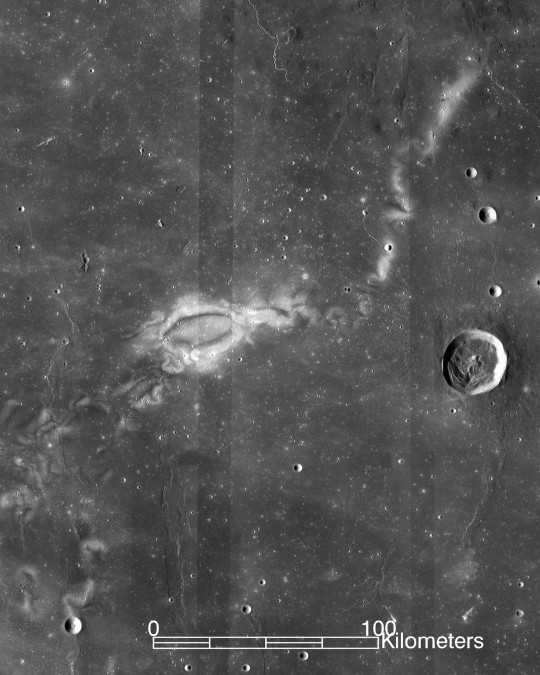
Fortunately, most of these charged particles cannot pass through the hulls of space stations, so astronauts are safe in orbit. Cosmic rays, made of stronger and faster-moving particles, are more dangerous. Even on Earth, under the atmosphere and magnetosphere, cosmic radiation reaches humans, though not enough to be considered damaging to our health.
A lander and rover launched in 2018 delivered the first measurements of radiation levels on the moon 4. Based on those data, astronauts on the moon can be exposed to up to 150 times higher radiation levels than on Earth.
Radiation is a leading reason for the pause in lunar landing missions. It raises risks of cataracts, heart diseases, radiation illness, cancer, and other ailments. Longer missions, of course, would heavily exacerbate these radiation doses.
Other Health Concerns
Cosmic rays contain High-Energy (HZE) ions. In different exposure such as from nuclear accidents or irradiation therapy, HZE ions have been found to cause dysregulation in the mitochondria and damage to DNA. Because of this, prolonged exposure is linked to health effects often associated with aging, such as hippocampus synapse loss and metabolic disruption caused by damage to mitochondrial DNA.
Long-duration space flights have also been linked to cardiovascular disorders. For astronauts on the Apollo missions, heart attack was “the second leading cause of death” 8. For additional space flights outside of Earth’s magnetosphere, astronauts also had a higher mortality rate due to cardiovascular diseases.
In a previous article, we discussed the relationship between circadian rhythms and health. These rhythms are another thing that space travel can impact, causing sleep and mental health disturbances in astronauts 9.
While various studies are investigating the conditions of these health risks, a current NASA mission is specifically investigating radiation protection.
Long-term Mission
NASA plans on eventually returning to human-manned missions to the moon.
First, they have to address the issues discussed above.
In November of 2022, Artemis I launched with two manikins bearing radiation detectors. From this mission, NASA was able to confirm the success of the intended trajectory, launch of ground systems, and the Orion spacecraft. The radiation results from this mission are still being analyzed.
The Artemis missions are intended to explore more of the moon than ever before, and lay groundwork for eventual missions to Mars.
Artemis II will not launch any earlier than September of 2025. It is planned to last ten days, consist of a 4-person crew, and be a lunar flyby to ensure the proper functioning of the spacecraft’s systems.
It has seemed for years that lunar exploration has halted. Manned missions have indeed been paused, for good reasons. Ensuring the safety of astronauts is a priority, and they face serious health risks even when missions go as expected. But NASA intends to continue exploring space, the moon, and Mars. The current Artemis missions are discovering improved, new ways to ensure the safety of astronauts while making scientific progress.
Additional Resources
1. https://science.nasa.gov/moon/solar-wind/
2. https://phys.org/news/2012-01-solar-flares-astronauts.html
3. https://arxiv.org/ftp/arxiv/papers/1211/1211.3962.pdf
4. https://link.springer.com/article/10.1007/s11214-020-00725-3
5.https://www.nasa.gov/missions/artemis/orion/orion-passengers-on-artemis-i-to-test-radiation-vest-for-deep-space-missions/
6.https://www.smithsonianmag.com/science-nature/how-space-radiation-threatens-lunar-exploration-180981415/
7.https://www.nasa.gov/humans-in-space/analysis-confirms-successful-artemis-i-moon-mission-reviews-continue-2/
8.https://www.frontiersin.org/journals/physiology/articles/10.3389/fphys.2020.00955/full
9. https://www.ncbi.nlm.nih.gov/pmc/articles/PMC9818606/
#radiation#moon#moon mission#nasa#nasa photos#article#research#solar wind#solar radiation#cosmic rays#cosmic radiation#space exploration#science#space#Work has been horribly busy so the next article might not be out on the usual schedule
19 notes
·
View notes
Text
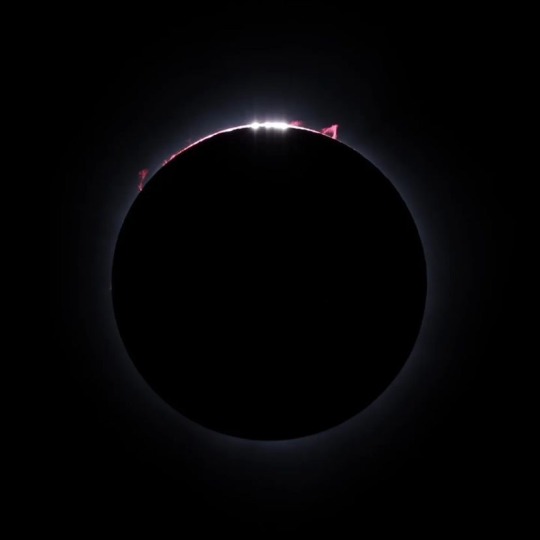
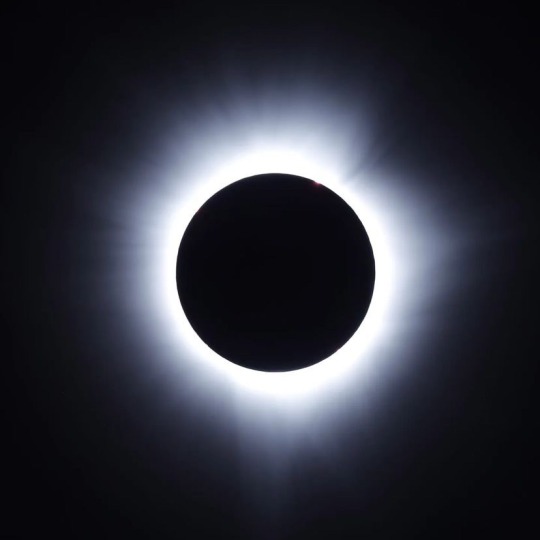




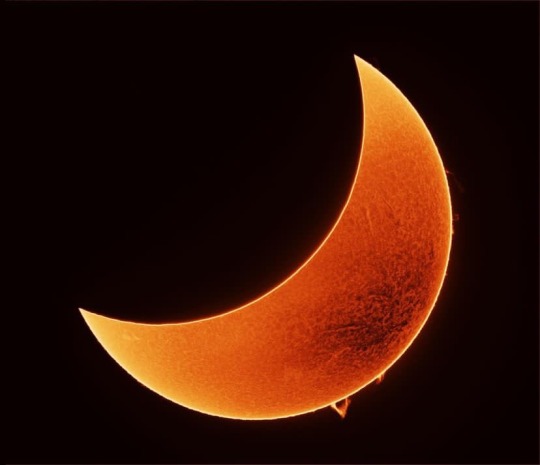

#eclipse 2024#eclispe#solar#solar eclipse#path of totality#astronomy#nasa#astronomers#universe#astrophotography#nasa photos#astrophysics#outer space#nasawebb#hubble space telescope#i love astronomy#astronomy facts#astrography#astrobiology#astro community#astro notes#astro observations#astroblr#planetary science#planetary nebula#galaxies#galaxy#space exploration#space#space science
873 notes
·
View notes
Video
youtube
Blue Ghost Moon Landing - 4 Incredible Angles of Firefly's Lunar Touchdown
I was very excited during the BlueGhost Mission, It was amazing! Here is some background on Blue Ghost ands the mission:
Blue Ghost Mission 1: Firefly’s Historic Lunar Landing
Firefly Aerospace’s Blue Ghost Mission 1, dubbed "Ghost Riders in the Sky," marked the first fully successful commercial soft landing on the Moon. Launched on January 15, 2025, and landing on March 2, 2025, it delivered 10 NASA payloads to Mare Crisium under the CLPS program. Here’s the scoop!
Mission Highlights
Launch: Jan 15, 2025, via SpaceX Falcon 9 from Kennedy Space Center.
Landing: Mar 2, 2025, at Mons Latreille, Mare Crisium.
Duration: ~60 days, with 14+ days of surface ops, surviving 5 hours into lunar night.
Data: Transmitted 119 GB, including 51 GB of science data.
The Lander
Named after the Phausis reticulata firefly, Blue Ghost is a 2m-tall, 3.5m-wide lander with:
Carbon composite structure for lightweight durability.
Three solar panels (400W) and robust X/S-band antennas for HD video.
1,000N main engine + eight 200N thrusters for precise landing.
Payloads
Carried 10 NASA payloads (94 kg), including:
RAC: Studied regolith stickiness.
NGLR: Enabled precise Earth-Moon distance measurements.
Lunar PlanetVac: Collected and sorted lunar soil.
LISTER: Drilled 3ft into the subsurface (hit hard rock).
SCALPSS 1.1: Captured 3D plume-surface imagery.
Eight payloads met objectives by Mar 6, 2025, supporting Artemis goals.
Cool Moments
Lunar Sunset: HD imagery of dust levitation on Mar 16, 2025.
Solar Eclipse: Captured a “diamond ring” effect on Mar 13-14, 2025.
First Images: Sent lunar surface pics 40 mins after landing.
Why It Matters
Blue Ghost’s upright landing and extended ops set a new bar for commercial lunar missions, paving the way for Artemis and future exploration. Firefly plans more missions in 2026 and 2028.
Check out more at Firefly Aerospace or NASA. Pics and videos on Firefly’s Flickr!
#youtube#blueghost#firefly#space m o o n that spells moon#moon#space#m o o n that spells moon#BlueGhostMission#Blue Ghost Mission#FireflyAerospace#Firefly Aerospace#MoonLanding#Moon Landing#NASACLPS#NASA CLPS#ArtemisProgram#Artemis Program#SpaceExploration#Space Exploration#LunarScience#Lunar Science#CommercialSpace#Commercial Space#MareCrisium#Mare Crisium#SpaceX#Space X#LunarLander#Lunar Lander#SpaceTech
2 notes
·
View notes
Text




"This photograph of the eclipse of the sun was taken with a 16mm motion picture camera from the Apollo 12 spacecraft during its trans-Earth journey home from the moon. The fascinating view was created when the Earth moved directly between the sun and the Apollo 12 spacecraft. Aboard Apollo 12 were astronauts Charles Conrad Jr., commander; Richard F. Gordon Jr., command module pilot; and Alan L. Bean, lunar module pilot. While astronauts Conrad and Bean descended in the Lunar Module (LM) Intrepid to explore the Ocean of Storms region of the moon, astronaut Gordon remained with the Command and Service Modules (CSM) Yankee Clipper in lunar orbit."
Date: November 18-21, 1969
NASA ID: AS12-51-7587, S80-37406, AS12-53-7927, AS12-53-7939, AS12-53-7940
#Apollo 12#Apollo CSM Block II#CSM-108#Yankee Clipper#Lunar Module#LM-6#Intrepid#NASA#Apollo Program#H-type mission#Lunar Orbit#Moon#eclipse#Earth#my post
31 notes
·
View notes
Link
Astronomy Daily - The Podcast: S03E182 Welcome to Astronomy Daily, your go-to Podcast for the latest in space and Astronomy news. I'm your host, Anna, and today's episode is a cosmic journey through a variety of fascinating topics that are sure to captivate and inspire. Highlights: - Fashion-Forward Spacesuits: Discover the collaboration between Italian luxury brand Prada and Houston-based startup Axiom Space to create the Axiom Extravehicular Mobility Unit for NASA's upcoming Artemis III mission. This cutting-edge spacesuit combines style with functionality, designed to withstand the extreme conditions of the lunar south pole. - Return of Vega C Rocket: Italy's Vega C rocket is set to make a comeback on December 3, marking a significant milestone for the Italian space program. This launch is eagerly anticipated by the scientific community and the space industry as it resumes its role in delivering payloads to orbit. - Rare Comet in Australian Skies: Comet C/2023 A3 (Tsuchinshan-ATLAS) is visible for the first time in 80,000 years, offering Australians a rare glimpse into the distant past. This celestial event is a reminder of the wonders that await when we look up at the night sky. - Brown Dwarf Mystery Solved: Astronomers have cracked a nearly 30-year-old mystery surrounding the brown dwarf Gliese 229 b, revealing it as a pair of brown dwarfs locked in a cosmic dance. This discovery provides valuable insights into the nature of brown dwarfs and the boundary between stars and planets. - Origins of Earth's Meteorites: A groundbreaking discovery traces 70% of Earth's meteorites back to three massive collisions in the main asteroid belt. This research sheds light on the origins of space rocks and helps track potentially dangerous asteroids. - Martian Solar Eclipse: NASA's Perseverance rover captures a stunning series of photographs of a solar eclipse on Mars, showcasing the planet's moon Phobos as it partially blocks the sun's disk. These images offer a unique glimpse of Phobos and Mars's complex orbital dynamics. - Boeing's Starliner Mission Uncertainty: NASA faces uncertainties regarding the next crewed mission of Boeing's Starliner spacecraft following issues during its first crewed test flight. The space agency is reviewing certification requirements to ensure safety and reliability for future missions. For more space news, visit our website at astronomydaily.io. There, you can sign up for our free Daily newsletter, catch up on all the latest space and Astronomy news with our constantly updating newsfeed, and listen to all our previous episodes. Don't forget to follow us on social media. Just search for #AstroDailyPod on Facebook, X, YouTubeMusic, and TikTok. Thank you for tuning in. This is Anna signing off. Until next time, keep looking up and stay curious about the wonders of our universe.
#artemis-iii#astronomy#axiom-space#brown-dwarfs#comet-c/2023-a3#eclipse#exploration#gliese229b#martian#meteorite#mission#nasa#origins#perseverance-rover#phobos#prada-spacesuit#rocket#solar#space#vega-c
0 notes
Text
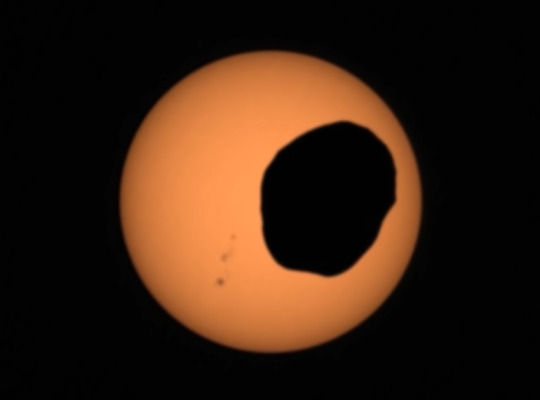
youtube
NASA's Perseverance Rover Sees Solar Eclipse on Mars
NASA’s Perseverance Mars rover used its Mastcam-Z camera system to shoot video of Phobos, one of Mars’ two moons, eclipsing the Sun. It’s the most zoomed-in, highest frame-rate observation of a Phobos solar eclipse ever taken from the Martian surface. Several Mars rovers have observed Phobos crossing in front of the Sun over the past 18 years. Spirit and Opportunity made the first observations back in 2004; Curiosity in 2019 was the first to record video of the event. Each time these eclipses are observed, they allow scientists to measure subtle shifts in Phobos’ orbit over time. The moon’s tidal forces pull on the deep interior of the Red Planet, as well as its crust and mantle; studying how much Phobos shifts over time reveals something about how resistant the crust and mantle are, and thus what kinds of materials they’re made of. The Mars 2020 Perseverance mission is part of NASA’s Moon to Mars exploration approach, which includes Artemis missions to the Moon that will help prepare for human exploration of the Red Planet. Credit: NASA/JPL-Caltech/ASU/MSSS/SSI
#Mars#Phobos#solar eclipse#eclipse#space#astronomy#astrophotography#Perseverance rover#NASA#religion is a mental illness#Youtube
31 notes
·
View notes
Text
Highlights of Eclipse Roadtrip today:
Learning so much about the Indy Speedway via talking to/listening to locals while standing in line
Seeing a talk by Real Astronauts (NASA, Virgin Galactic, and Blue Origin) about topics ranging from hopes for the future of space exploration to what they found the most unexpected about traveling into space
Talks by NASA folks that got me excited about the Artemis program in spite of myself
Chicago style polish sausage (because the food carts were not prepared for this many people)
OH MY GOD A DEMON ATE THE SUN oh no wait, it spit it back out, never mind
In all seriousness though, easily my top 5 life experiences, eerie and transcendental. Videos and photos can never do it justice, and experiencing it with a crowd, yelling periodically as totality neared and then cheering once it hit and again when totality ended was great fun
I saw the total eclipse in 2017 in Nebraska, but that was under so much cloud cover that I couldn’t see the corona. This time I could, and it was beautiful. A delicate ring of white, interrupted by orange beads of solar prominences, with the eponymous softly glowing white crown around it. All while it was dark in the middle of the afternoon
The sun coming back was like a sudden spotlight, except everywhere
Surprisingly good exhibit at the Indiana State Museum tying in the first prehistoric settlers of the area and connecting what we know about them to modern tribes today and their traditions. Very good at being explicit that these through lines connect to people who are here now.
The rest of the museum was also VERY well done, wish I’d had more time there
Also they had functional giant eclipse glasses out front, which was a delight
Total Eclipse of the Heart beer at local brewery. Brewed with Eclipse Hops, natch
15 notes
·
View notes